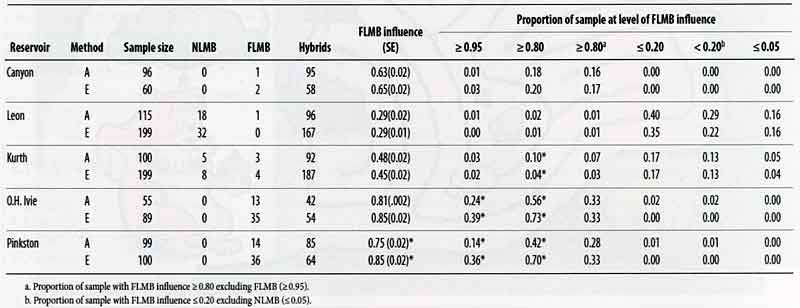Mixing the two sub-species of largemouth bass (Florida - FLMB and Northern - NLMB ) to achieve the result of bigger fish while retaining good catch rates has been a goal of many a fisheries manager for years. Now we have another scientific point of light, titled Subspecies Composition of Angled and Electrofished Largemouth Bass in Texas Reservoirs, Dijar J. Lutz-Carrillo, and Spencer Dumont in Proceedings of the Annual Conference of the Southeast Association of Fish and Wildlife. Agencies 66:75-81, 2012 Proc., to add more knowledge to the equation.
The study's results provide biologists with a provocative concept that, in southern waters (natural integrated zone of FLMB and NLMB), FLMB likely are more difficult to angle than NLMB, but the phenotype (genetic trait) of reduced angler susceptibility (catchability) is mitigated (reduced) by introgression (genetic mixing), even at low levels of NLMB genes.
While many factors may function concurrently to determine angling susceptibility, including fishing pressure, naivety of individual fish, learned lure avoidance, and stress from catch and release, we now know that catchability is a genetic and heritable trait as was previously discussed in earlier Cutting Edge articles (see Garrett [2002] and Philipp et al. [2009]).
See the Table below from the study which provides some eye catching numbers. A few quickly got my attention. Even when there were roughly twice as many NLMB in the survey as FLMB, the cross population showed almost 50% Florida genetics. In one instance where there was roughly 15 times the number of NLMB as FLMB, the cross population showed 29% Florida genetics. The number of crosses in the tests far outnumbered either FLMB or NLMB. I bet if you look you can spot a few more.

Note that when pure FLMB were removed from the dataset numbers (leaving only crosses with high levels of FLMB genetic influence) the trait of reduced catchability disappeared. Stated differently, the addition of only a small amount of NLMB genetics caused poor catchability to disappear. Catch rates rise with NLMB genetics, compared to pure Florida bass genetics
One interesting aspect of this study is the incorporation of a substantial amount of information from unpublished Texas Parks and Wildlife Department studies.
Assuming the electrofished collections were a reflection of the true composition of the population, these results suggest that FLMB were more difficult to angle than expected, based on their frequency in the population, and that NLMB were angled at expected rates. Thus, in a scenario where both subspecies exist in equal proportions, we would expect FLMB to be more difficult to angle relative to NLMB.
Electrofishing has been the preferred method for collecting non-biased samples of largemouth bass for genetics studies over the last three decades, and while capture rates may differ among seasons and throughout the day, no bias in the collection of either subspecies has been observed in numerous studies. Additionally, one study reported that largemouth bass collected using rotenone and electrofishing from impoundments exhibited no differences in genotype frequencies.
In two lakes, fish with high levels of FLMB influence (crosses and FLMB) were collected at significantly greater rates by electrofishing than angling. However, when the pure FLMB were removed from the dataset (leaving only crosses with high levels of FLMB influence) these differences between gear types disappeared. This suggests that the initial differences between gear types was skewed by the disproportionate number of FLMB collected by electrofishing and that crosses, even with high levels of FLMB influence, were collected at expected rates. Therefore, if FLMB and crosses with high FLMB influence were present in equal proportions, it would be expected that FLMB would be more difficult to angle than the crosses.
The distribution of LMB subspecies and their crosses are not identical; however, habitat preferences and distributional patterns appear to be more similar between the subspecies in southern impoundments than elsewhere. This, I suggest, is because the southern region is where FLMB and NLMB naturally coexist and crossbreed, leaving high populations of crosses.
It appears that the introgressed fish (FLMB/ NLMB crosses of all %, F-l through Fx predominate and trend toward greater FLMB gene expression (see trophy fish comment below).
Trophy fish (>13 lbs.) from introgressed populations are represented disproportionately as non-introgressed FLMB relative to the frequency of FLMB in the general population (TPWD, unpublished data). Thus, in an appropriate environment, genetic composition appears to be a critical component of maximum size in largemouth bass. While most of the differences in growth and maximum size between these subspecies are likely due to intrinsic physiological differences, behavioral differences such as reduced angling susceptibility, may also play a role. FLMB that are potentially less susceptible to angling would be removed from populations at reduced rates relative to non-introgressed NLMB or crosses, allowing a greater proportion of FLMB to reach an older age and greater size. However, I recall TPWD data also showing many of the Sharelunker fish were high FLMB percentage crosses.
Well, we are now one step further along the road to understanding FLMB and NLMB and their crosses. While it is early in the process, most fisheries scientists now agree that FLMB can grow larger and are harder to catch. This study is the first to show that with a few NLMB genes in the population (individual) that the dreaded trait of reduced catchability can be greatly diminished. This was suggested in some of the early studies, but not isolated in crosses as has been done here. You might, if you are in the south (natural integrated area), consider adding a few NLMB to your FLMB only waters to improve catchability. At low rates the NLMB genes don't seem to reduce growth and size in the crosses.
Reprinted with permission from Pond Boss Magazine



